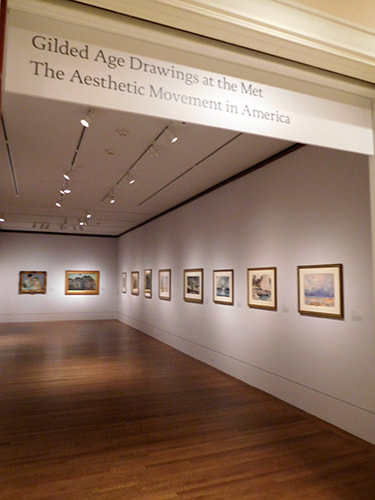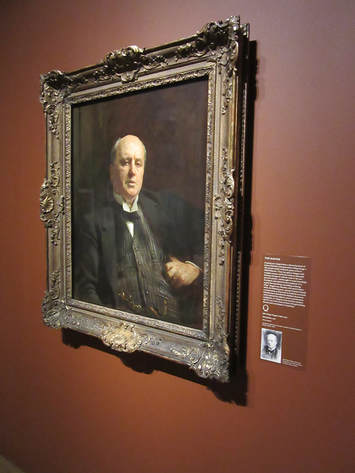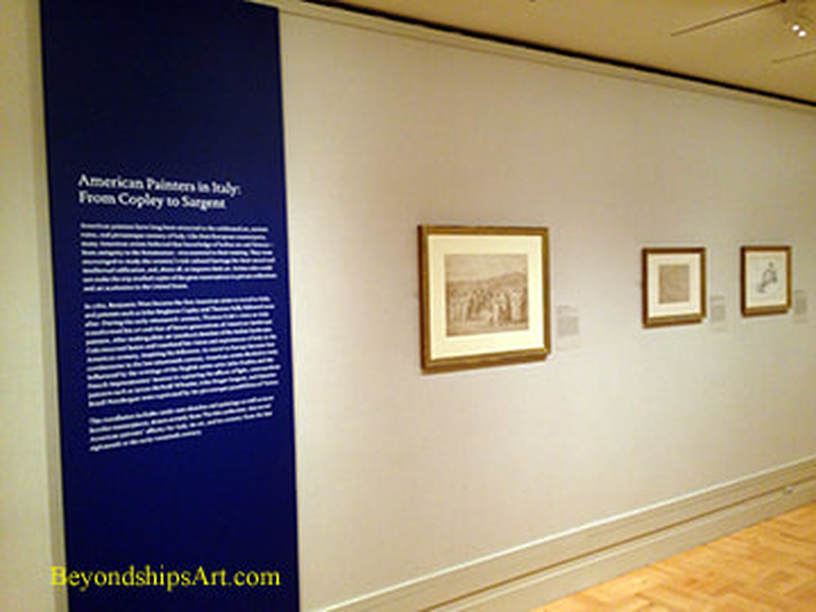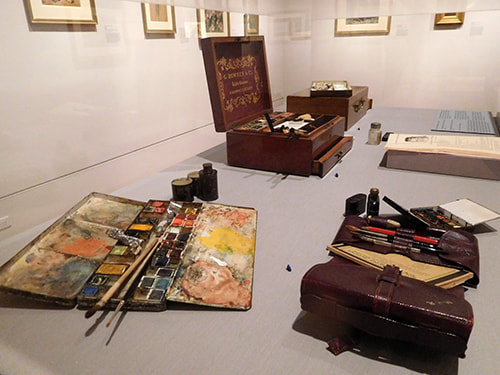|
“American Painters in Italy: From Copley to Sargent” at the Metropolitan Museum of Art is an intimate exhibition of works from 18 American artists illustrating the influence of Italy on their art. Drawn from the museum's collection, it includes drawings and sketches as well as a number of watercolor paintings.
In the 18th and 19th centuries, people interested in pursuing a career in art were encouraged to travel to Italy to study that country's long artistic history and culture. Of course, only a few had the means to make the arduous trip across the Atlantic from America. Still, beginning with Benjamin West in 1760, a number of American artists who would later achieve lasting fame made the journey. For example, Thomas Cole traveled to Italy in 1825 during a sojourn that took him to England and several European capitals. In Italy, he enrolled in art classes in Florence and made copies of works by Italian Renaissance masters. He also ventured out and made sketches of the Italian landscape. When he returned to the United States, he incorporated what he had learned in his landscapes. Thus, Cole's time in Italy can be said to have influenced the Hudson River School and American landscape painting. The exhibition contains a number of works done as part of such educational journeys. For example, there is a page of drawings by Thomas Sully of works by Michelangelo. There is also a watercolor copy by Julian Alden Weir of a painting by Botticelli. Italy's influence on American artists is shown in other ways. For example, J. Carroll Beckwith's chalk drawing called “The Veronese Print.” is a portrait of a Victorian era woman.. The reference to the Italian Renaissance master Paolo Veronese in the picture's title is to a print on the wall behind the sitter. Of course, American artists traveled to Italy for purposes other than studying. In 1879, James McNeil Whistler traveled to Venice to do a series of etchings for the Fine Art Society in London. While he was there, he did nearly 100 pastel drawings of the city. His “Note in Pink and Brown” is an intriguing drawing of a scene from one of Venice's canals. Whistler omits unnecessary detail to produce a vague, dream-like atmosphere. The highlight of the exhibition is a series of watercolors by John Singer Sargent. Born in Florence, Italy to expatriate American parents, Sargent traveled often to Italy. Most of these watercolors are landscapes of Venice or studies of architectural features. His watercolors are freer than the commissioned portraits for which he is best known. Furthermore, the colors are more vivid in the watercolors, more like those of his friend Claude Monet.  In my view, this exhibition is mislabeled. The title “Gilded Age Drawings at the Met” suggests a collection of black and white sketches of hefty figures supposed to be gods and goddesses from Greek mythology or other syrupy themes that were popular in the late Victorian age. In reality, this exhibit is a delightful small group of colorful watercolors and pastels done by artists whose work has transcended their time. Included in this exhibition at New York's Metropolitan Museum of Art are several watercolors by John Singer Sargent. Sargent was one of the most successful portrait painters of his day. However, he also did watercolors. These were not intended for public display but rather were for his own benefit. As a result, they are done in a very loose style using a palette reflecting the fact that he also spent time working with Monet and the Impressionism. Most of the Sargent watercolors are landscapes or other Impressionistic scenes. However, there is also a small watercolor done during World War I when he visited the front lines as a war artist. It is of two men suffering from the effects of mustard gas and is a very powerful piece. Thomas Eakins is also represented. Unlike Sargent, Eakins exhibited his watercolors and they bear a close resemblance to the style he used in his oil paintings. These are illustration-like scenes from everyday life including the controversial “Dancing Lesson.” Is it a sympathetic illustration of black life shortly after emancipation or is it meant as a comedy that re-enforces racial stereotypes? The signage appears to conclude the former noting that it won a silver medal when it was exhibited in Boston in the 1870s. There are also several watercolors by Winslow Homer. These capture the various moods and energy of the sea in a variety of scenes. Homer manipulated the watercolors to produce amazing sea and sky effects. James McNeill Whistler was also a successful Victorian era artist. However, his style looked more toward the future than the art establishment of the day. “His Lady in Grey” is a tiny watercolor that is similar in concept to some his full-length female portraits. I sometimes come across comments on social media about whether a watercolor should be just translucent paint. However, in almost all of these works, the masters used gouache (opaque watercolor) along with the translucent watercolors. Not all the works in this exhibit are watercolors. There are also two pastels by Mary Cassat. One is a large, yet tender, finished work that returns to her favorite theme - - the relationship between a mother and her child. The other work is more of a sketch on colored paper showing a woman on a bench knitting. There is a great deal of energy in the Impressionist master's short, seemingly rapid, strokes. There are also works by artists who are less well-known to the general public. Jane Peterson's scene of a New York City street during the patriotic parades around World War I complements Childe Hassan's popular paintings of those days. Charles Ethan Porter, an African American artists who specialized in still lifes is also represented. John LaFarge did not try to capture the image of flowers with absolute realism but rather sought to capture their essence thus foreshadowing the century which followed. Also on display are some artist boxes from the late 19th century. What is surprising is that the pans and tubes of watercolor paint and the brushes do not look much different than those of today.  Henry James by John Singer Sargent at the Morgan Library and Museum Henry James by John Singer Sargent at the Morgan Library and Museum “Henry James and American Painting” at the Morgan Library and Museum explored the relationship between one of the 19th century's foremost authors and several visual artists. Henry James was born in 1843 into a wealthy family from Albany, New York. However, he spent much of his early life traveling around Europe. When the family returned to the United States, it settled in Newport, Rhode Island but subsequently moved to Boston, Massachusetts. During this time, James developed friendships with many of the great minds of New England such as the jurist Oliver Wendell Holmes Jr. He also embarked on a career as a writer. In 1869, James returned to Europe where he would stay for most of the rest of his life. He became a central figure in the American ex-patriot community. And, as documented in this exhibit, many of his friends were artists. James saw the creative process of the novelist as being analogous to the creative process of the visual artist. In addition, he often used references to visual art in his writings His more experimental later works have been compared to Impressionist painting. Perhaps the best known American artist living in Europe during this period was John Singer Sargent. James knew Sargent, wrote about him and sat for portraits by him. In addition to a formal portrait commissioned by James' friends to mark his seventieth birthday, the exhibit had a number of more informal works by Sargent. These included portraits of friends as well as a series of watercolors and oils done by Sargent while in Venice. As the signage in the exhibit indicated, several were works that James had known and/or commented upon. In addition to their connection to James, these informal works were of interest because they showed Sargent's style free of the economic pressures and constraints of his commissioned portraits. In fact, the watercolors were never intended for sale or exhibition. The style in such informal works is looser and more free. The portrait of writer Robert Louis Stevenson and his wife borders on the abstract. It is much more 20th century than 19th century. James was also friends with another famous American ex-patriot, James McNeill Whistler. In fact, James modeled one of the characters in his book The Ambassadors after Whistler. The exhibit had fewer works by Whistler than by Sargent. “Arrangement in Black and Brown – The Fur Jacket” is a large vertical portrait of a woman. Like Sargent, Whistler had the ability to create intriguing portraits of women, using vagueness to create a sense of mystery. James also created portraits of women in his novels. Not all of James' artist friends are as well known today as Sargent and Whistler. Lilla Cabot Perry was an American who joined with the community of artists that sprung up around Claude Monet when he was living in Giverny, France . Her portrait of her daughter reflects the strong Impressionist influence. According to the signs at the exhibit, the relationship between American painters Frank Duveneck and Elizabeth Boott Duveneck and Elizabeth's father, inspired parts of three of James' novels. Elizabeth's father viewed Frank Duveneck as his social inferior and so was against his daughter marrying him. The exhibit had Duveneck's formal portrait of his father-in-law, presenting a very proud and imperial figure. Elizabeth died early on and the exhibit also had the tomb sculpture that Frank carved for her. In addition to the paintings and other art work, the exhibit had manuscripts and letters that James wrote to various artists. The exhibit presented a unique bridge between the world of literature and the visual arts. Considering that the Morgan is a museum founded upon a library, the exhibit was highly appropriate. |
AuthorRich Wagner is a writer, photographer and artist. Archives
November 2018
Categories
All
|


 RSS Feed
RSS Feed